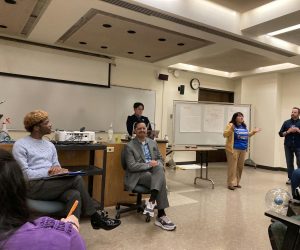Where is the Soul?
December 5, 2012
Graphic by Nicholas Joy
Graphic by Nicholas Joy
In recent years, scientific attempts to prove the existence of the soul through quantum physics have only succeeded in finding that the observer changes that which is observed. The film What the Bleep Do We Know comes to mind. In it, New Age gurus use quantum verbiage to propose all kinds of metaphysical hypothesis without fully understanding the complex world of quantum physics, of which scientist Richard Feynman has been quoted, most famously by Richard Dawkins, as saying “If you think you understand quantum theory, then you don’t understand quantum theory”.
The experiments that led to the discovery of the “observer effect” are indeed fascinating, and mark the beginning of what might evolve into a bona-fide metaphysical science. But to say that they prove the existence of a supernatural soul, or of something that has inherent reality and is eternal and independent of external factors (including “that which is observed”) is taking it too far.
The first instance of philosophical speculation regarding the seen and the seer as ways to articulate the existence of atma (soul, or being) take place in the ancient Vedic tradition of Hinduism where sages pointed out that seer and seen are one, that there can be no seer without that which is seen (and sometimes vice-versa, since the mind with its naming capabilities is a reality-creating machine), and that both body and mind are part of ‘that which is seen’ (by the self, or the seer). Therefore, for ages Hindu thinkers have been asking themselves “Where is the Self / the Seer?”
It’s often been cited (particularly within the shamanic religious traditions) that the fact that we dream is evidence that there is an out-of-body reality that the soul partakes in and we now know that dreams are the result of the pineal gland’s activity. Terence McKenna and other DMT researchers point out that magic mushrooms activate the pineal gland and that it has the power to produce hallucinations and create the appearance of colors that we see when we dream. Hindus and New Agers now equate the pineal gland with the third eye.
Our attempt to discern if there is a soul should include a study of the etymology of words like spirit, which has its roots in breath. Again, we are brought back to shamanic religious traditions where, at the time of death, our primitive ancestors noticed that the breath left the body and at the time of birth, breath entered the body. Spirit means breath in Latin. In the Gospels, the word that Jesus used for the Spirit was Ruach, a feminine noun that translates as Breath and which his followers personified as the Holy Ghost.
In yoga, there is no distinction between the cultivation of our spirits and the cultivation of breath: breathing exercises not only have the power to hone our attention and strengthen our bodies and immune systems. Breath is what feeds the body. We can spend days without food but only minutes without breath. Even public speakers are taught a lower belly breathing technique to have more control over their emotions.
Breath is also interpersonal: the ceremony of smoking the pipe of piece consolidates friendships, precisely, because we are sharing our breath. A deep kiss, where breath is shared, is another intimate act of giving oneself. Humans have always considered breath a very intimate part of ourselves, but again, this is not a supernatural idea. There are also poetic or platonic concepts of soul as having to do with what gives meaning to or that which resonates with one’s life (twin souls, soul purpose). Our sense of destiny is tied to our concepts of soul.
Finally, the subject of where the soul resides requires an exploration of the mind, which is at times confused for the self. The Greek for soul was psyche, a word which gave birth to our modern field of psychology (the study of the soul). But here, rhetoric is confusing and anyone who has ever practiced zazen, or sitting meditation, knows that the mind and its activities can be observed and the mind is therefore not the seer but the seen. In Buddhism, all reality originates or becomes defined within the mind.
In the article ‘Killing the Buddha’, neurologist Sam Harris argues that we need a new science of contemplation free of the trappings of organized religions. But we also need a new set of words if we are to free our contemporary, scientific form of spirituality from the inertia of its superstitious origins. Words have power, including the power to confuse, and part of the role of researchers trying to understand the self is to employ words that are not speculatory and have the intended meaning.
Sam Harris argues that Zen Buddhists have the beginnings of this science of contemplation. They also have interesting non-supernatural verbiage for spiritual reality. The belief that the only reality exists now and that we should anchor our awareness in the now, and the lack of an immortal self has resulted in the use of the term presence in Buddhist practice. For instance, we may see sutras where practitioners are invited to say “May I be a kind and loving presence in this world”, etc.
The Buddhist notion of reality as essentially impermanent and constantly changing accepts no nouns, only verbs, processes, constant becoming. For instance, to an awakened being there is no tree: a tree has to have been a seed, then taken hold as roots and grown, it has to have been the water, the solar energy and soil nutrients that fed it. All these variables are the tree. There is therefore no self to speak of, instead there are variables that, when they are found together, produce a phenomenon that feels like an identity, a self. Without the aggregates this self vanishes. All things have causes and variables. This is known in Buddhism as codependent origination, or interbeing, and resonates with Native American notions of ‘all our relations’.
We are temporary presences in this world, and this is an awe-inspiring reality, but we are not the eternal, undying entities that our megalomania (and our fear of death) has led so many of us to believe. There is absolutely no reason to think that humans, of all the trillions of entities in our planet, and probably our universe, are immortal souls that live on after death.







